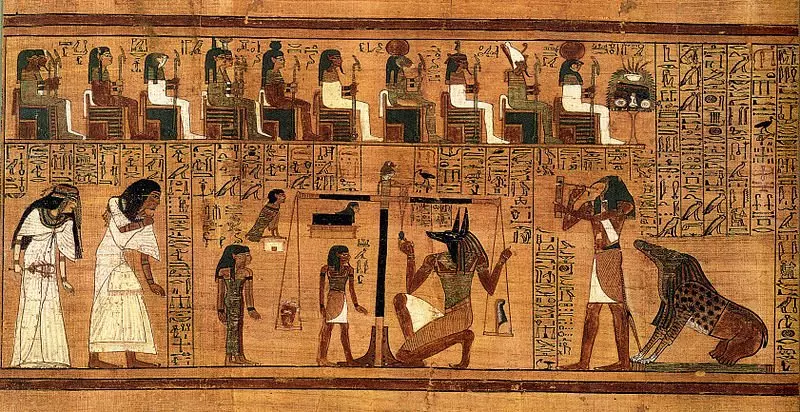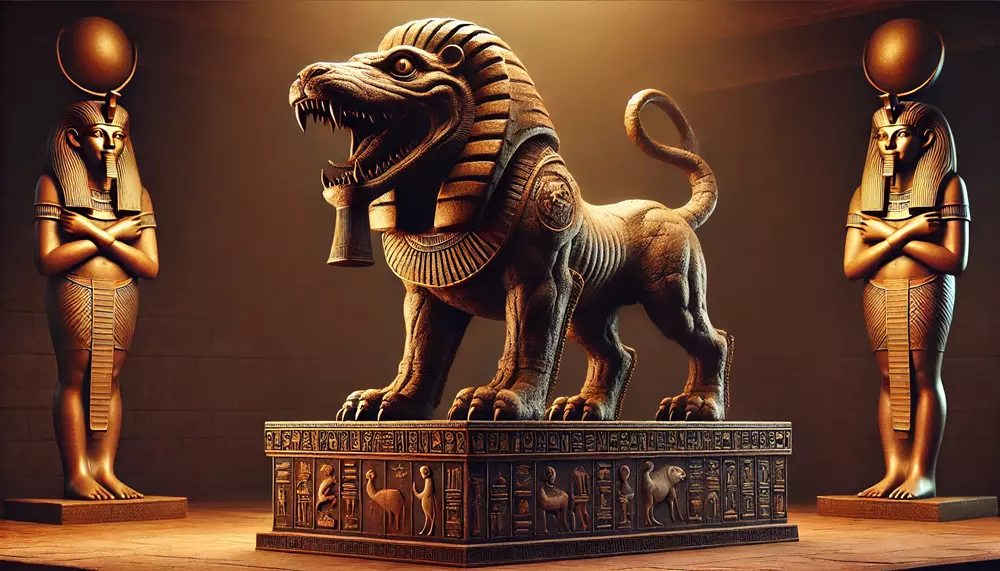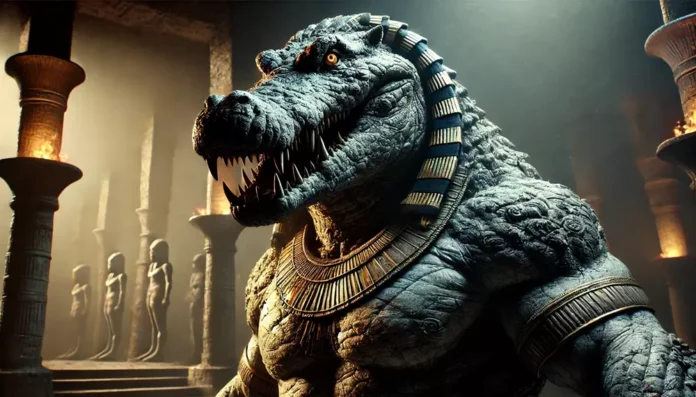Introduction
Ammit, the “Devourer of the Dead,” is a creature from Ancient Egyptian mythology with a fearsome purpose: to consume the hearts of the wicked in the afterlife. Part lion, crocodile, and hippo, Ammit’s presence signified final judgment.
With traits from three of Egypt’s most feared animals, she stood as an ultimate enforcer of justice, ensuring only the worthy could pass into the afterlife.
History/Origin
Ammit’s story begins in the heart of Ancient Egypt, a civilization deeply preoccupied with the concept of the afterlife. Rooted in the “Book of the Dead” and various funerary texts, Ammit’s origins are entwined with Egypt’s beliefs surrounding death and judgment.
Positioned in the Hall of Two Truths, Ammit awaited the hearts of the deceased who were brought before the god Osiris. If a soul was deemed unworthy, Ammit would devour its heart, condemning it to eternal nonexistence.
As the representation of divine justice, Ammit’s role reinforced a belief in moral responsibility, a reminder to the living that unethical actions had consequences beyond death.
Name Meaning
In Egyptian, “Ammit” translates to “Devourer” or “Eater of the Dead.” Her name reflects her ominous purpose in the afterlife.
Egyptian texts occasionally refer to her by other titles, such as the “Devourer of Souls,” which further emphasizes her role in the judgment process. The meaning embedded in her name resonated across Egyptian society, symbolizing the fears and moral codes of her time.
Background Story
In the Egyptian afterlife, each deceased soul would enter the Hall of Two Truths, where the heart was weighed against Ma’at’s feather of truth. If the heart was heavier, symbolizing a life burdened with sin, Ammit devoured it, condemning the soul to oblivion.
She embodied the finality of failure and was feared by all. Legends claim that even powerful Pharaohs dreaded her, for Ammit did not discriminate in her judgments.
She enforced an unyielding balance between good and evil, symbolizing ultimate retribution in the afterlife.

“Those judged unworthy face the jaws of Ammit, who awaits their final missteps.”
Ammit’s presence alone was a warning that life’s moral choices would be reckoned with, long after death.
Cultural Impact
The concept of Ammit left a profound mark on Egyptian society, symbolizing justice and moral consequence. Stories of her actions reinforced ethical behavior, as people feared an eternity in limbo if their heart proved unworthy.
Ammit’s role in cultural expressions like tomb inscriptions, religious texts, and carvings gave her an enduring place in Egypt’s spiritual life. Pharaohs and common folk alike revered the judgment process, and Ammit became a central figure in funerary rites, illustrating Egypt’s intricate moral beliefs.
Similar Beasts
Ammit’s role as a divine enforcer has parallels across cultures. For instance, the Greek Cerberus guarded the Underworld’s gates to prevent souls from escaping, while the Hindu deity Yama oversees the fate of souls in Hinduism.
Similarly, Mesopotamian mythology speaks of Ereshkigal, queen of the underworld, who judges the dead. These beings share Ammit’s role as guardians and executors of divine justice.
Religion/Ritual
In Ancient Egypt, Ammit’s function extended beyond myth, impacting religious rituals around death. Priests would prepare for the weighing ceremony, crafting spells to aid the soul’s journey in the “Book of the Dead.”
Ammit herself was not worshipped but feared, a symbolic force. Many Egyptians wore protective amulets and recited prayers, hoping to secure a lighter heart.
Her image was inscribed on tomb walls to remind those passing into the afterlife of the stakes involved.
“Ammit, the Devourer, awaits all hearts, for none may pass who fail her test.”
This reminder served as a ritualistic warning to all, underscoring the importance of moral purity before Osiris.
Scientific or Rational Explanations
Though modern interpretations may view Ammit as a psychological manifestation of Egypt’s strict morality, some historians see her symbolism as part of Egypt’s social control. By associating moral failure with a monster who consumed hearts, Egyptian rulers and priests reinforced ethical behavior.
Ammit can also be seen as a representation of human fear around death and judgment, personifying the consequences of immorality. Her hybrid appearance, combining Egypt’s most fearsome animals, speaks to the psychological power of symbols in influencing societal norms.

Modern Cultural References
Ammit’s image and role have carried over into modern literature, media, and popular culture, often embodying ideas of justice and punishment:
Film: In The Mummy series, Ammit is referenced as part of Egypt’s underworld lore.
Books: Rick Riordan’s Kane Chronicles incorporates Ammit in its portrayal of Egyptian mythology, highlighting her role in judgment.
Video Games: Ammit appears in Assassin’s Creed Origins, as a guardian figure enforcing justice in the afterlife.
Television: In Moon Knight, Ammit is a central figure, symbolizing judgment and balance, aligning with Egyptian myths.
Art: Contemporary artists draw inspiration from Ammit to explore themes of death and moral consequence.
Comics: Ammit has a cameo in Marvel Comics, further embedding her image as a fearsome judge.
Museums: Exhibits on Egyptian mythology often feature Ammit sculptures, offering audiences a glimpse into ancient beliefs about the afterlife.
Educational Platforms: Documentaries about Egyptian mythology frequently mention Ammit’s role, emphasizing her lasting impact on historical and religious studies.
Tattoo Culture: Some people incorporate Ammit’s image into body art, symbolizing their views on justice and morality.
Conclusion
Ammit, the Devourer of the Dead, embodies ancient Egypt’s intense focus on morality, justice, and the afterlife. Her role in the judgment of souls instilled moral discipline in Egyptian society, reminding people of the consequences of sin.
As a composite creature, part lion, hippo, and crocodile, she represented the ultimate predator of unworthy souls, reinforcing Egypt’s complex worldview. Today, Ammit endures as a symbol of justice and accountability, showing how ancient beliefs about judgment still resonate within modern society.
Her story warns that justice, no matter how harsh, awaits everyone, inspiring awe and fear across centuries.






